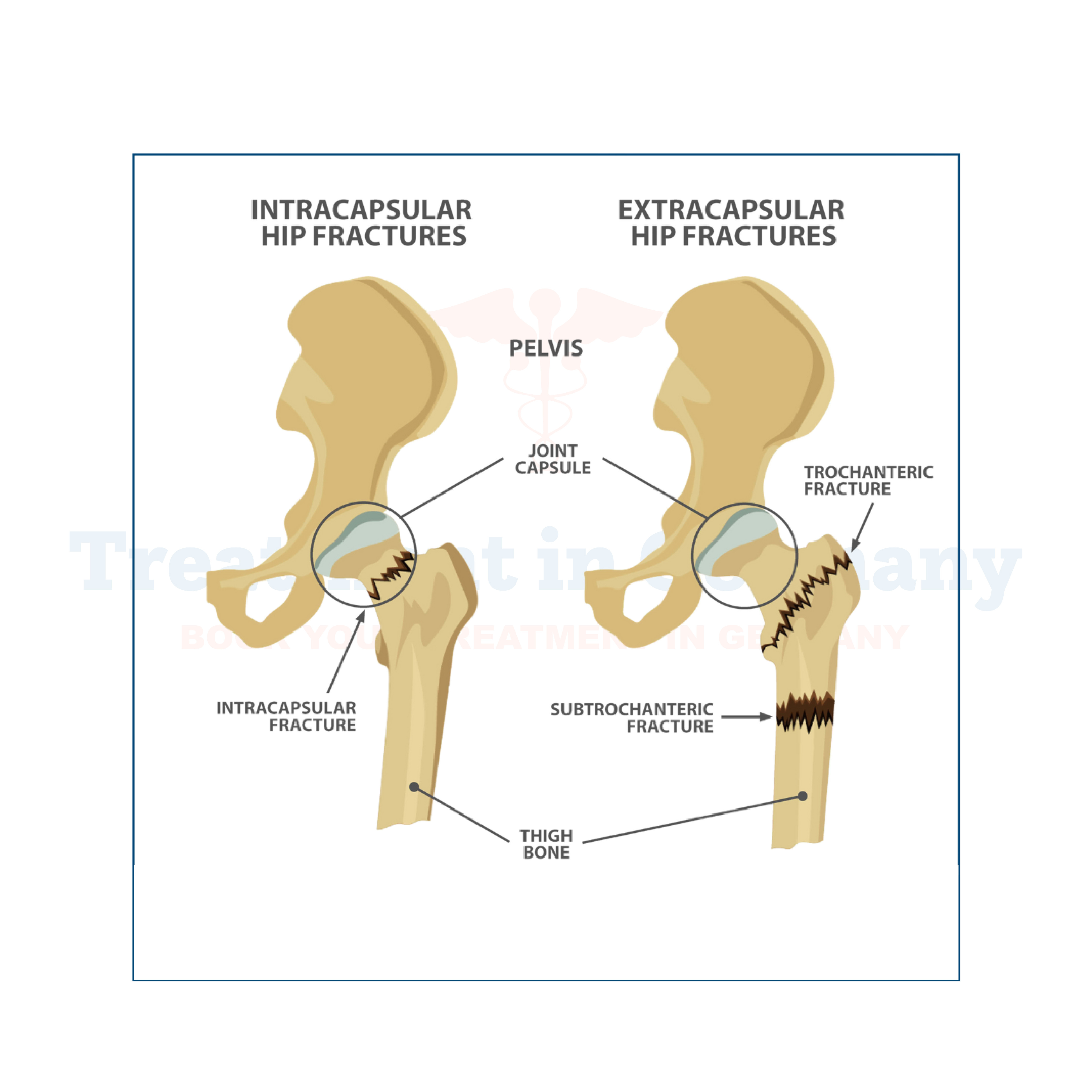Hip Fractures Treatment in Germany
Hip fractures are a serious medical condition that occurs when the upper part of the femur (thigh bone) breaks due to trauma, falls, or underlying bone diseases. These fractures can lead to severe pain, immobility, and complications if not treated promptly. Older adults and individuals with osteoporosis are at a higher risk of hip fractures. Germany has become a leading destination for advanced hip fracture treatment, offering cutting-edge surgical techniques, rehabilitation programs, and innovative therapies.
Types of Hip Fractures
Hip fractures are classified based on the location of the break in the femur:
- Femoral Neck Fracture: A break occurring just below the ball of the hip joint. This type of fracture can disrupt blood flow to the femoral head, leading to complications.
- Intertrochanteric Fracture: A fracture occurring in the upper region of the femur, between the femoral neck and the shaft of the bone. It is easier to treat than a femoral neck fracture.
- Subtrochanteric Fracture: A fracture occurring below the intertrochanteric region, which requires more complex treatment due to the involvement of the femur shaft.
Risk Factors
Several factors increase the likelihood of experiencing a hip fracture, including:
- Age: Older adults, especially those over 65, are at higher risk.
- Osteoporosis: A condition that weakens bones, making them more susceptible to fractures.
- Obesity: Excess weight puts additional strain on bones and joints.
- Diabetes and High Cholesterol (Hyperlipidemia): Can contribute to poor bone health.
- Falls and Trauma: Loss of balance, weak muscles, or accidents can result in fractures.
- Sedentary Lifestyle: Lack of physical activity weakens bones and muscles.
- Autoimmune Diseases: Conditions such as rheumatoid arthritis can weaken bones over time.
Symptoms of Hip Fractures
Common symptoms of hip fractures include:
- Severe Pain: Sharp pain in the hip or groin area.
- Swelling and Bruising: The affected area may become swollen and discolored.
- Inability to Stand or Walk: Movement becomes difficult or impossible.
- Shortened or Rotated Leg: The fractured leg may appear shorter or turned outward.
- Limited Range of Motion: Difficulty in moving the hip joint.
Diagnosis and Diagnostic Tools
Early and accurate diagnosis is essential for effective treatment. German hospitals use advanced diagnostic methods, including:
- Physical Examination: Doctors assess hip stability, pain level, and mobility.
- X-rays: Provide clear images of the fracture location and severity.
- MRI (Magnetic Resonance Imaging): Detects soft tissue damage and hidden fractures.
- CT (Computed Tomography) Scan: Creates detailed cross-sectional images of the hip joint.
- Bone Density Tests: Helps in assessing osteoporosis-related risks.
- Blood Tests: To check for underlying conditions affecting bone health.
Treatment in Germany
Germany is a global leader in orthopedic treatments, offering highly effective options for hip fractures, including:
Surgical Treatments
- Internal Fixation: Metal plates, screws, or rods are used to stabilize the fractured bone.
- Hip Replacement Surgery: A total or partial hip replacement may be required for severe fractures.
- Minimally Invasive Surgery: Reduces recovery time and surgical risks.
- Bone Grafting: Used in cases where bone healing needs to be enhanced.
Post-Surgical Rehabilitation
- Physical Therapy: Strengthens muscles and restores mobility.
- Pain Management: Medications and therapies to reduce discomfor
- Nutritional Support: Ensuring optimal bone health through diet and supplements.
Innovative Therapies in Germany
Germany is at the forefront of medical innovation, offering advanced therapies for hip fracture recovery:
- Stem Cell Therapy: Used for bone regeneration and faster healing.
- TACE (Transarterial Chemoembolization): Being explored for its role in inflammatory joint diseases.
- Dendritic Cell Therapy: Investigated for its potential in autoimmune-related bone damage.
- 3D-Printed Implants: Custom-made hip implants for improved mobility and comfort.
- Robot-Assisted Surgery: Enhances precision in fracture repair and hip replacement procedures.
- Bioengineering and Gene Therapy: Developing new solutions for bone regeneration.
Why is it Preferable to Get Treatment in Germany?
Germany is one of the top destinations for orthopedic care due to:
- Innovative Treatment Methods: Utilization of the latest technologies in hip fracture management.
- Highly Skilled Surgeons: Experienced orthopedic specialists providing top-tier care.
- World-Class Hospitals: Equipped with state-of-the-art surgical and rehabilitation facilities.
- Personalized Treatment Plans: Customized therapies based on individual needs.
- Comprehensive Rehabilitation Programs: Ensuring long-term recovery and function.
- Affordable Medical Packages: Competitive pricing for international patients.
- High Success Rate: Excellent outcomes in fracture treatment and recovery.
Solutions and Prevention
Preventing hip fractures involves lifestyle modifications and proactive healthcare measures:
- Regular Exercise: Strengthens bones and muscles, improving balanc
. - Maintaining a Healthy Weight: Reduces strain on the hip joints.
- Calcium and Vitamin D Intake: Essential for bone strength.
- Fall Prevention Strategies: Using assistive devices and home modifications for elderly individuals.
- Routine Bone Density Tests: Helps in early detection of osteoporosis.
- Proper Footwear: Wearing non-slip shoes to reduce fall risk.
- Early Treatment for Symptoms: Seeking medical attention at the first sign of joint pain or weakness.
Conclusion
Hip fractures are a serious condition that requires prompt medical intervention to prevent long-term complications. Germany offers world-class treatment options, including innovative surgical techniques, regenerative medicine, and advanced rehabilitation programs. With highly skilled surgeons, state-of-the-art hospitals, and groundbreaking therapies, Germany remains a leading destination for hip fracture treatment. By taking preventive measures and seeking timely medical care, individuals can reduce the risk of hip fractures and ensure better mobility and quality of life.
If you or a loved one is considering treatment for a hip fracture, Germany provides some of the most advanced and effective options available today. The combination of expert doctors, modern hospitals, and innovative treatment approaches ensures the best possible recovery outcomes for patients dealing with hip fractures.
👉 Contact us for further information and receive a complimentary consultation.

.webp)
.webp)
 (1).webp)
 (1).webp)

.webp)
.webp)
 (1).webp)
 (1).webp)
